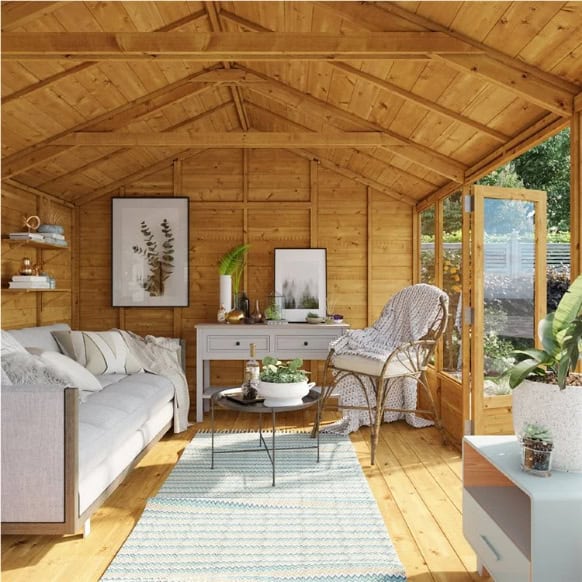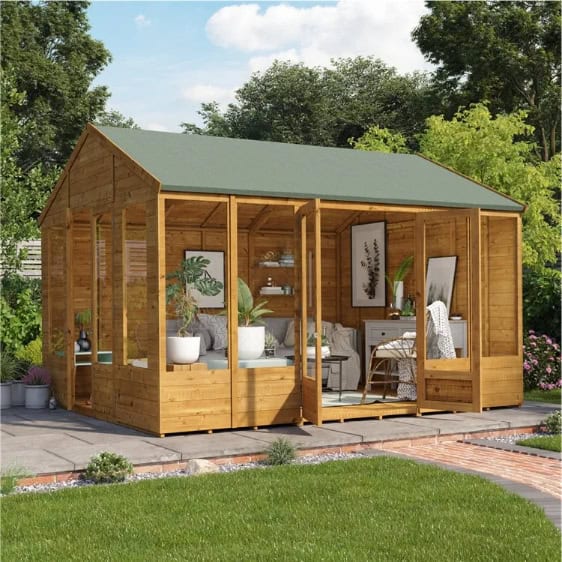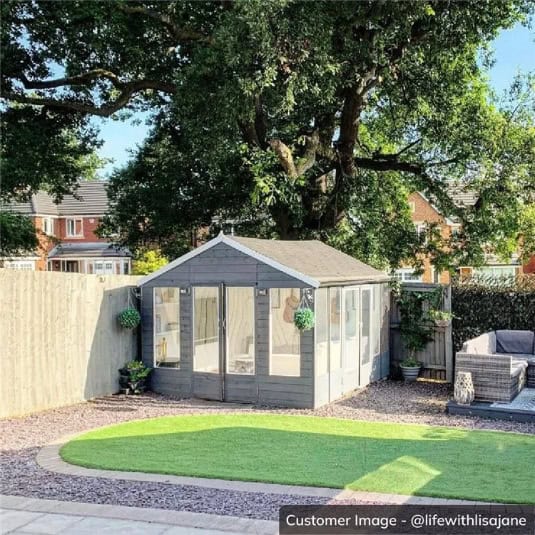Jump to:
Your summer house will probably see a lot of activity in the warm weather. Whether you are about to open it up for the new season or you need to keep it in good condition over the winter, this guide provides the essential steps to maintain your wooden garden house lovely and fresh for when you’re ready to enjoy it.
Do Inspections on Both the Exterior and Interior

Regular inspections are crucial to catch potential issues early. Don’t wait for cracks in the walls or mould growth on the ceiling to appear. Make it a habit to inspect your summer house at least once a year to identify signs of wear and tear, and take action before small problems escalate into costly repairs. That way, you can take measures before issues get worse.
Begin by examining the base or foundation to see if it provides the stability you need. Next, check for leaks or holes, as these will allow pests to enter and water to seep in. Seal any openings you find, including on the windows and doors, with putty or wood filler. Allow the sealant to dry and harden up before sanding it flat.
Roof maintenance
The roof is one of the most vulnerable parts of your summer house and can suffer some wear and tear from harsh weather conditions. Inspect the roof regularly for damage, including worn mineral felt or shingles, and repair any issues immediately. After a storm in your area, check for damage caused by falling branches and debris. This is when the majority of damage occurs.
Glazing
Even if you have toughened glass, breaks can still occur. If there are cracks, glazing can be easily replaced. You can contact the original building supplier, or a window company or DIY store should be able to provide replacement glazing in the size you need.
Door and window hinges
The doors of a summerhouse can get opened and shut a lot, making them more susceptible to damages. Hinges may wear over time, leading to doors tilting or being unable to close properly. Tighten or replace the hinges to keep them upright. If the doorframe has taken damage, replacement material will be required.
Ventilate the Summer House

While your summer house serves its purpose as a retreat to enjoy during summer, it’s important to let air out. As the weather warms up, you may notice more condensation building up inside. This routine helps control moisture, improve air quality, and deter pests.
Simply open the doors for a couple of hours regularly to allow condensation to dry out and dissipate, and maybe put a fan inside to help with airflow. When the summer house isn’t used during winter, you can come back in spring to find it musty or with a strong odor. Airing out also creates less favourable conditions for pests to nest and feed. Try to also remove anything which could be a source of humidity, such as plants, over the winter.
TIP: Opening the double doors and windows twice a week can massively lower the risk of damp and mildew, especially during the colder months. Just make sure you do this when it’s not raining.
For more detailed advice, check out our separate guide on how to prevent condensation in a summerhouse.
Treat and Paint your Wooden Summerhouse
Perhaps the most important maintenance task for a wooden building is treatment, which is achieved by painting it with either wood stain or coloured wood paint. If left untreated, timber can absorb moisture, leading to rot and damage. Prevent this and enhance your summerhouse protection by applying the right wood treatment. Do so as soon as the structure is installed, and repeat once a year for effective moisture repellence. It is important to apply a fresh coat even if you can’t see any gaps or flaking, to make sure water can’t possibly seep through. This maintenance is also crucial for upholding the manufacturer’s warranty on your summerhouse.
The best time to treat your wooden summer house is towards the end of summer, perhaps in early September, after the summer storms have finished but before the cold weather begins. This gives you the opportunity to do the job on a day where it’s still warm outside, while providing fresh protection ahead of when it’s most needed.

A fresh coat of paint or stain will also renew the appearance of your summerhouse, keeping it looking its best and enhancing its aesthetic value. You might as well do the same for the interior using these summer house paint ideas.
Tip: Consider investing in a pressure-treated summerhouse for less frequent re-retreatment. Read our guide, ‘How Long Does Pressure Treated Wood Last?’ to learn more.
Checking for bugs
As the temperature changes, numerous bugs and insects find their way into our homes and garden buildings. Whilst most bugs are harmless and can in fact help our gardens to thrive, some insects can hinder the quality of the wood. It’s a great idea to check your garden sheds and other garden buildings regularly. This is so you can remove any pests!
That’s it for our summer house maintenance tips! With a little care and attention, your summer house will stay functional and beautiful for years to come. Ready to roll up your sleeves and get started? Check out our other guides to help you maintain your garden buildings, or get in touch if you need expert advice.
Looking at investing in a new one? Our summerhouse buying guide has everything you need to make an informed decision.
Up next on your reading list: How to Clean Your Summer House Ready for Summer










